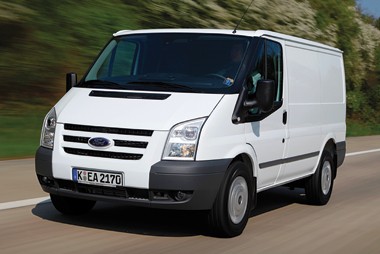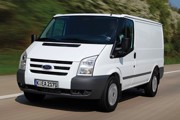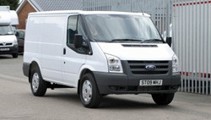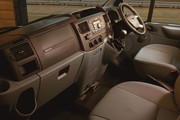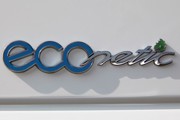Review
A welcome side-effect of ‘greening up’ a fleet operation is that it will save money too.
Obvious, really – lower CO2 emissions come with better fuel economy, while an environmental strategy usually involves either travelling fewer miles at lower speeds, or squeezing more miles per gallon from an existing engine.
With the double whammy of helping fleets save the planet and helping them save cash in the process, Ford has set out to produce a new range of vans that aim to do just that – with a side order of lower CO2 emissions as an extra relish.
Ford already offers Econetic versions of many cars and this moniker has now been extended to the commercial vehicle sector, with greener versions of the Transit and Fiesta Van available later in the year.
A new Transit Econetic is available to order now and Steve Kimber, Ford’s commercial vehicle director, hopes there will be more models to come.
At the launch in Munich, he told Fleet Van: “This is the beginning of a challenge as there are no high roof versions yet. But it’s a big step forward and we would like to see a full Econetic van range eventually.”
The Transit Econetic is based on the front-wheel drive Transit 280S panel van with short wheelbase and 2.2-litre 115bhp Duratorq TDCi engine.
Target fuel economy is 39.2 mpg, an increase of 13% over the standard model, while CO2 emissions are 189g/km. The Transit Econetic is the first Ford commercial vehicle to meet Euro 5 emission standards.
To create the Econetic, components from the Transit were selected and combined with high fuel economy and low emissions levels as the priority.
The engine has been re-calibrated and a new standard speed limiter has been introduced. With this device in place, the top speed of the Econetic is 70mph. To prevent potential
manipulation of the limiter unit, it has been hard-coded.
Longer gearing has been achieved through fitting a 4.36 final drive ratio. Larger 16-inch steel wheels with 215/75 R16 lower rolling resistance tyres are used, while a full-size spare wheel cover is fitted to help reduce aerodynamic drag.
The larger wheel diameter also leads to a reduction in engine rev levels at all speeds.
Engineering for the new model includes reducing the availability of the heaviest options such as a second sliding door.
However, all standard and optional safety and comfort features have not been changed.
Transit Econetic comes as standard with ESP traction control, including hill launch assist (HLA) and a full steel bulkhead.
Features such as air conditioning, rear parking sensors and a new rear view camera with overhead seven-inch colour display can also be ordered.
Kimber said that as yet no prices had been revealed but he hinted that there would be a ‘modest’ increase over the standard model. He also declined to speculate on sales targets.
The Fiesta Van Econetic will be powered by a specially-calibrated version of the 90bhp 1.6-litre Duratorq TDCi engine and will offer a fuel economy figure of 76.4 mpg on the combined cycle and CO2 emissions of 98g/km.
Behind the wheel
It is a fact that while going green – as with this van – will save fuel and money, there is usually a downside. In the case of cars, it’s often sluggish performance, leaving drivers frustrated and liable to use an even heavier right foot.
The same problems don’t exist with vans, yet still there’s a price to be paid. We don’t yet know what that ‘modest’ price increase will be and we are told that the Transit Econetic won’t be able to tow as much weight as its standard brother.
But as long as towing and modest price increases don’t come into your fleet equation, this van is likely to prove very attractive indeed.
Chatting with Steve Kimber, it became obvious that while 39.2mpg is the official mpg target, a figure in the low-40s is quite achievable as long as the van isn’t used for heavy loads on stop-start journeys.
Indeed, I can personally vouch for that as our current long-term test Transit, which sports the same engine, is at present returning 36.4mpg without all the green modifications attached.
Our Munich test drive featured a good 150 miles or so of varied terrain. With a 600kg load of sand in the back, I honestly couldn’t tell the difference in performance from my van back at home – until I hit 70mph, of course, when the speed limiter cut in.
But even this safety device is introduced in such a smooth way that it didn’t really intrude.
Drivers presented with a governed-down van will soon get used to the fact that they can’t thrash it illegally and will settle down to a much more relaxed – and safer – style of driving.
As for the general driving experience, there isn’t a lot on the roads to beat Britain’s top-selling van. ESP traction control comes as standard and ride and handling are little short of superb.
I also like the little green arrow that flashes on the dashboard to tell you the optimum time to change up a gear. It might sound a bit of a gimmick but I reckon it could save around 1mpg for most drivers – you do find yourself following its instructions.
Verdict
It’s hats off to Ford for taking the time and effort in these cash-strapped days to think of green issues.
While, on their own, lower CO2 emissions won’t save fleets any money at present, they certainly won’t harm a company’s green image.
But the prospect of 13% lower fuel bills will certainly make van operators take notice.



